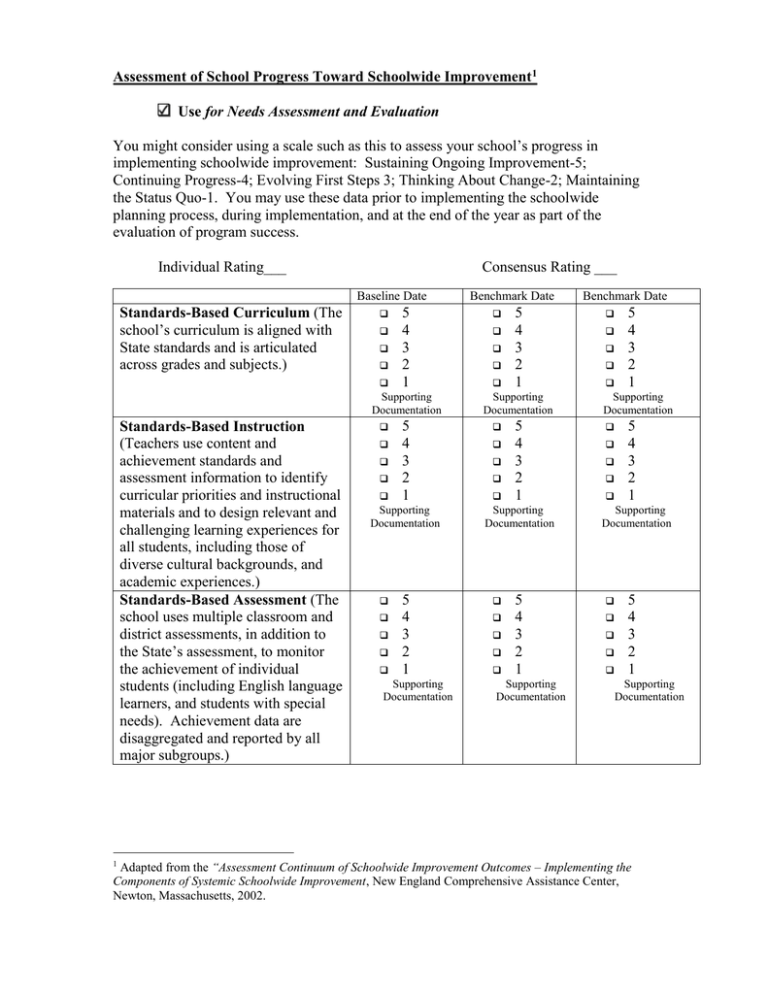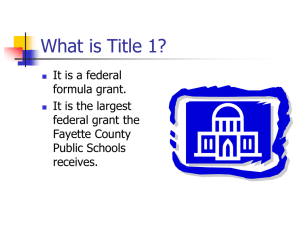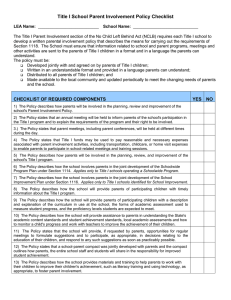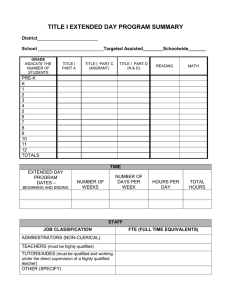Assessment of School Progress Toward Schoolwide Improvement for
advertisement

Assessment of School Progress Toward Schoolwide Improvement1 Use for Needs Assessment and Evaluation You might consider using a scale such as this to assess your school’s progress in implementing schoolwide improvement: Sustaining Ongoing Improvement-5; Continuing Progress-4; Evolving First Steps 3; Thinking About Change-2; Maintaining the Status Quo-1. You may use these data prior to implementing the schoolwide planning process, during implementation, and at the end of the year as part of the evaluation of program success. Individual Rating___ Consensus Rating ___ Baseline Date Standards-Based Curriculum (The school’s curriculum is aligned with State standards and is articulated across grades and subjects.) 5 4 3 2 1 Supporting Documentation Standards-Based Instruction (Teachers use content and achievement standards and assessment information to identify curricular priorities and instructional materials and to design relevant and challenging learning experiences for all students, including those of diverse cultural backgrounds, and academic experiences.) Standards-Based Assessment (The school uses multiple classroom and district assessments, in addition to the State’s assessment, to monitor the achievement of individual students (including English language learners, and students with special needs). Achievement data are disaggregated and reported by all major subgroups.) 5 4 3 2 1 Supporting Documentation 5 4 3 2 1 Supporting Documentation Benchmark Date 5 4 3 2 1 Supporting Documentation 5 4 3 2 1 Supporting Documentation 5 4 3 2 1 Supporting Documentation Benchmark Date 5 4 3 2 1 Supporting Documentation 5 4 3 2 1 Supporting Documentation 5 4 3 2 1 Supporting Documentation Adapted from the “Assessment Continuum of Schoolwide Improvement Outcomes – Implementing the Components of Systemic Schoolwide Improvement, New England Comprehensive Assistance Center, Newton, Massachusetts, 2002. 1 Baseline Date Data-Based Accountability and Evaluation (The school has a fully implemented accountability system that includes a school improvement plan based on disaggregated achievement and other data.) Structural Reform Strategies (The school structures its schedule, organization, support mechanisms, and resources to provide all students equal access to resources and the support to achieve to high standards.) Leadership and Governance (The school improvement team, or other governance structure includes teachers, other non-instructional staff, parents, community members and students in a shared leadership structure to support and improve school programs.) Professional Development (The school has a structure and process for developing and implementing a professional development plan that is aligned with the schoolwide program goals; the plan is researchbased, and helps staff to better meet the needs of students.) Culture and Climate (The school’s philosophy, norms, values, beliefs and shared vision reflect expectations for high achievement for all students, collaboration and collegiality among all staff, and mutual respect and trust among all individuals; the school is safe and orderly and is welcoming to students and their families.) 5 4 3 2 1 Supporting Documentation 5 4 3 2 1 Supporting Documentation 5 4 3 2 1 Supporting Documentation 5 4 3 2 1 Supporting Documentation 5 4 3 2 1 Supporting Documentation Benchmark Date 5 4 3 2 1 Supporting Documentation 5 4 3 2 1 Supporting Documentation 5 4 3 2 1 Supporting Documentation 5 4 3 2 1 Supporting Documentation 5 4 3 2 1 Supporting Documentation Benchmark Date 5 4 3 2 1 Supporting Documentation 5 4 3 2 1 Supporting Documentation 5 4 3 2 1 Supporting Documentation 5 4 3 2 1 Supporting Documentation 5 4 3 2 1 Supporting Documentation Baseline Date External Support and Resources (The school accesses external support and resources from a variety of sources to implement, supplement and/or extend goals. Use of external resources is based on thorough research of their effectiveness and alignment with the schoolwide program plan.) Parent and Community Involvement (The school has active partnerships with parents and linkages to community organizations and institutions; the community is actively engaged and supports the activities of the school.) Extended Learning Activities (The school provides informal learning experiences and extracurricular activities, such as sports, music, art and clubs that appeal to diverse populations; these offerings are provided directly or through community partnerships.) 5 4 3 2 1 Supporting Documentation 5 4 3 2 1 Supporting Documentation 5 4 3 2 1 Supporting Documentation Benchmark Date 5 4 3 2 1 Supporting Documentation 5 4 3 2 1 Supporting Documentation 5 4 3 2 1 Supporting Documentation Benchmark Date 5 4 3 2 1 Supporting Documentation 5 4 3 2 1 Supporting Documentation 5 4 3 2 1 Supporting Documentation Indicators for the School Profile2 Use for the needs assessment This table contains possible indicators that can be used to complete the school profile that is part of the needs assessment process, and also can be used to develop the schoolwide plan. Daily Attendance Mobility/Stability Socioeconomic Status Student Behavior Limited English Proficiency 2 Student Demographics Enrollment Student Achievement Academic Performance Other Performance-based Data Possible Indicators The number of students in the school; students in special programs (Title I, special education, gifted and talented), by ethnicity or other meaningful categories. Number of students attending school by grade, grade span, whole school, or other enrollment category. The percent of students tardy for classes. The mobility rate is the percentage of children who move in and out of a school during a year. The stability rate refers to the percent of students who remain in the same building for the entire year. Percent of students receiving free and reduced lunch, parents’ education level, parents’ household income, unemployment rates in the attendance area, etc. The number or percentage of discipline referrals or incidents; the number or percentage of student suspensions and expulsions; frequency of gangrelated, substance abuse or other at-risk behavior. The percentage of students with limited English proficiency. The percentage of families who speak English as a second language. Possible Indicators State and local tests; levels of proficiency attained; progress on desired outcomes: results of performance assessments or student portfolios, examples of student work, classroom assessments and grades. Information from portfolios, exhibits, performance assessments that describe student standards-based achievement. Adapted from Creating a School Profile, RMC Research Corporation, Denver, Colorado ,1998. Multi-year Trends Academic achievement data from several years Completion Rates Promotion/graduation rate, retention rates Comparative Data Performance of disadvantaged students against all other meaningful categories of students in the school or in the district; comparison of performances of students in various ethnic or programmatic subgroups (i.e., students with learning disabilities, limited English speakers, migrant students, etc.). Post Secondary Number or percent of students attending and/or completing post-secondary schools; number or percent of students accepted in the armed forces. Possible Indicators Expectations that are communicated to the community, teachers, parents and students about what students can and should learn, including written standards, goals or benchmarks that reflect classroom and school practice and are based on State standards. Instructional activities, programs or strategies used to teach the State content and achievement standards. The amount and quality of instructional materials, including textbooks, supplementary resources, publication dates of the grade level-adopted texts; the extent to which available materials are consistent with State standards. The extent to which teachers use technology as a means to increase student achievement; type of computer system(s) available to students, faculty and administration for instructional purposes; availability of modern equipment, software and printers, especially appropriate adaptive devices and software tools to serve the needs of students with disabilities. Supplementary use of paraprofessionals and other staff; available professional and paraprofessional staff to assist students, particularly the lowest achieving, to include students with disabilities, and those with limited English proficiency. Possible Indicators Curriculum and Instruction Learning Expectations Instructional Program Instructional Materials Instructional Technology Support Personnel High-quality Professional Staff Staff Preparation Number of teachers, administrators, years of teaching or administrative experience; types of certificates held, other special skills or knowledge. Staff Specialists, and other Support Staff Professional Development Staff Demographics School Administrators Family and Community Involvement Parental Involvement Number of content or program specialists such as reading teachers, mathematics or science specialists, counselors or psychologists, social workers, health staff, etc. The existence of district and school-level professional opportunities available to teachers; the number of professional days or district resources dedicated to professional development; evaluations of professional development sessions and the amount of teacher-generated professional development. Ethnicity, gender breakdowns of staff and administration, retirement projections, and an analysis of whether the ethnicity of the school staff reflects the same ethnic groups as students. Number of administrators and roles; years of experience, specialized training and advanced degrees. Possible Indicators Evidence of a parental involvement plan for volunteering, home learning activities, program review and development. Communication with Parents Amount and frequency of information disseminated to parents, and the quality of information disseminated; use of multiple languages. Amount and frequency of opportunities for involvement in decision-making. Parent Community Roles Parent Training The type of training opportunities offered to parents; parent workshop evaluations; evidence of teachers trained in parental involvement. Support for Families Health Services School Context and Organization School Mission/Vision Availability of information, training and services to adequately address the educational needs of students with learning disabilities or special educational needs as a result of poverty, limited English proficiency, or migratory life style. Availability of school-linked health and social services for students and families, including counselors, psychologists, medical professionals, and nurse practitioners. Possible Indicators Statement of the underlying philosophy of the school. Average Class Size School Climate Coordination Plan Management and Governance Student Discipline Policy Staff/child ratio, average class size, computed by grade or grade spans. The quality of student-teacher interactions, student attitudes toward school, teacher job satisfaction, teacher expectations and beliefs about what students can accomplish. A description of the activities conducted to ensure that students’ instructional day or program is coordinated so that student learning is not fragmented. The presence of engaged principals, teacher input into decision-making, the organization of teachers by teams. Clearly defined and articulated student management and discipline policy, including policies that pertain to students with disabilities. Data Collection Guide3 Use for the needs assessment and also the evaluation The following chart is designed to help the school planning team collect and manage information collected for the comprehensive needs assessment. Fill in specific sources of information you have from current sources, then list any additional information you need to collect. Make sure that you have sufficient data to make judgments about the status of each focus area. Methods of Data Collection Self Assessment Student Curriculum High-quality Family and School Achievement and Professional Community Context and Instruction Development Involvement Organization Observations Interviews and/or Surveys School Records Group Discussions Evaluation/Data Reports Student Work Other Information 3 This tool was adapted from a chart originally published in Implementing Schoolwide Programs: An Idea Book on Planning, Volume 1, U.S. Department of Education, Washington, D.C., 1998, with permission from WestEd. Finalizing the Schoolwide Plan – A Rubric for Monitoring and Evaluation Use to develop the schoolwide plan, and also for evaluation This model was developed by the Iowa Department of Education as a rubric for schools to use to assess the quality of their schoolwide plans. The rubric suggests a “three-star” system that highlights the desired qualities/behaviors observed in effective schoolwide programs. 10 Components of a Schoolwide Plan Comprehensive Needs Assessment Exceptional ٭ Includes a variety of data gathered from multiple sources. Acceptable ٭٭ Includes data gathered from two sources. Needs Revision ٭٭٭ Includes data gathered from less than two sources. Examines student, teacher, school and community strengths and needs. Examines student strengths and needs. Examines student deficits. 10 Components of a Schoolwide Plan School Reform Strategies Exceptional ٭ Strategies increase the quality and quantity of instruction, using research-based methods and strategies. Acceptable ٭٭ Increased the quality and quantity of instruction. Needs Revision ٭٭٭ Increases neither the quality nor quantity of instruction. Research-based reform strategies are directly aligned with the findings of the needs assessment. Reform strategies aligned with the findings of the needs assessment. Reform strategies are not directly aligned with the comprehensive needs assessment findings and do not reference research-based models. Provides a detailed, enriched and accelerated curriculum for all students. Provides an enriched and accelerated curriculum for select students with plans in place to move toward all students. Provides a basic curriculum. Addresses the needs of all children in the school, but particularly those who are low achieving, and meets the needs of students representing all major subgroups participating in the schoolwide program. Addresses the needs of all children in the school, but particularly the needs of students of target populations participating in the schoolwide program. Addresses the needs of select students and there is no clear plan in place that addresses how the school will determine if identified needs are met. Addresses specific strategies that assist teachers to determine if student needs are met. Briefly addresses how the school will determine if these needs are met. Teachers are directed to meet student needs without specific strategies or approaches. 10 Components of a Schoolwide Plan Instruction by Highly Qualified Professional Staff High-quality and Ongoing Professional Development Exceptional ٭ Teachers and paraprofessionals meet the highly qualified requirements; parents are aware of the highly qualified status of all teachers. Acceptable ٭٭ Teachers and paraprofessionals are prepared to meet the highly qualified requirements, however, all do not; parents are aware of the progress of the school in meeting this requirement. Needs Revision ٭٭٭ Teachers and paraprofessionals, for the most part, do not meet the highly qualified requirements, and there is no plan in place to meet the requirement. All teachers are assigned to the areas in which they are certified to teach. Teachers are sometimes assigned to areas in which they are not certified. Teachers are routinely assigned to teach in areas where they are not certified. All staff is trained to meet individual needs of all students, but particularly the lowest achieving students of any program that is included in the schoolwide program. Most staff receives training toward meeting the needs of only select groups of students. Some staff receives fragmented training unrelated to identified school needs. All staff receives ongoing and sustained professional development that is aligned with the goals of the school improvement plan. Most staff receives ongoing and sustained professional development that is mostly aligned with the goals of the school improvement plan. Few staff receives professional development; it addresses their individual training goals and is not necessarily aligned with the goals of the school improvement plan. 10 Components of a Schoolwide Plan Strategies to Attract Highly Qualified Staff Strategies to Increase Parental Involvement Exceptional ٭ Acceptable ٭٭ Needs Revision ٭٭٭ The school is allowed to provide incentives for highly qualified teachers to teach in high need schools. The school has developed a plan to review the qualifications of its staff, and is prepared to adopt an incentive structure for novice and experienced teachers. The school makes teacher assignments based on the availability of staff, and does not have a plan to make changes in the way it assigns or hires teachers. Only teachers who are highly qualified are assigned to low achieving students and this is the policy throughout the district. Teachers who do not meet the highly qualified status are rarely assigned to work with high need students. Teachers are not assigned to serve high need students based on student need, but rather staff availability. Specific strategies to increase parental involvement, based upon results of the needs assessment have been identified and implemented. Specific strategies to increase parental involvement have been identified and implemented. Specific strategies to increase parental involvement have not been identified or implemented. Strong collaboration with community resources is evident. Some collaboration with community resources is evident. No collaboration with community resources is observed. Parents are included as decision makers in a broad spectrum of school decisions. Parents are included as decision makers in a limited number of school decisions. Parents have no role in the decision making process of the school. 10 Components of a Schoolwide Plan Preschool Transition Strategies Teacher Participation in Making Assessment Decisions Exceptional ٭ Collaboration is evident between the elementary school and preschool programs (i.e. Head Start, Even Start). Acceptable ٭٭ Collaboration efforts have begun between the elementary and preschool programs. Needs Revision ٭٭٭ Collaboration and communication seldom occurs between the regular elementary school program and preschool programs. Specific strategies for helping students’ transition into the elementary setting have been identified and implemented. Specific strategies for helping students’ transition into the regular elementary school setting are not included in the school improvement plan. Specific strategies for helping students’ transition into the regular elementary setting have not been identified or implemented. A team of teachers, administrators and parents participate in the selection, use, and interpretation of school-based assessments. Student performance is considered when modifying the school improvement plan. Assessment decisions are made with little or no input from teaching staff. Student performance drives modifications and improvements in the selection and use of schoolbased assessments. Student performance is considered when modifying the plan, however, it does not always occur. Student performance is not considered when making decisions about assessment. 10 Components of a Schoolwide Plan Timely and Additional Assistance to Students Having Difficulty Mastering the Standards Coordination and Integration of Federal, State and Local Programs and Resources Exceptional ٭ The school has a well-defined process that is currently being implemented to identify students experiencing difficulty mastering the State’s standards. Acceptable ٭٭ The school has a process in place to identify students experiencing difficulty mastering the State’s standards. Needs Revision ٭٭٭ No process is in place to identify students who are experiencing difficult mastering the State’s standards. Timely, effective and additional assistance is provided for students experiencing difficulty mastering the State’s standards. Effective, additional assistance is provided for students experiencing difficulty meeting State standards. Additional assistance is provided to some students who are experiencing difficulty, but the intervention is not regular and ongoing. Thematic, integrated instruction, designed to accommodate the needs of various learning styles is provided. Students receive some differentiated instruction while working with support staff. The school has established its improvement plan based on need, and is knowledgeable about and uses all resources available to the school to meet its goals. The school has established its improvement plan based on need, but plans to conduct a full inventory of its resources in order to carry out its goals. Printed with the permission of the Iowa State Department of Education All students are taught using the same methods. The school has an improvement plan, but its goals are not always based on need, and there is uncertainty as to what the available resources are, and how they can be used to address its goals.






